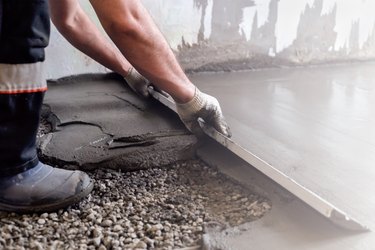Adding a design element, sheen or slick of color to a plain, dreary concrete floor can pump up your space from drab to fabulous. There are quite a few options for color, application and coating, so if you are deciding to bring up the level of style on your floor, you have some big decisions to make. The DIY-friendly and inexpensive project gives you a lot of bang for your buck and time investment.

Video of the Day
Dyes vs. Stains
The development of synthetic dyes has widely increased the array of colors for decorating concrete flooring, walls and structures. Dyes are different from stains in that they contain very fine color pigments, along the lines of an ink solution that can easily breach into the tight construction of concrete. Dyes don't react to the surface of the concrete as stains do. They adhere to the makeup of the material and, therefore, leave a more permanent mark. This makes for a more uniform color rather than a wash of stain that leaves a more variegated look. A top coat or clear sealer should be applied to lock in the color because dyes are not UV stable and can fade within months without protection. Stains come in solid or semi-transparent colors that can be removed at certain points to control the color as it reacts to the concrete.
Video of the Day
Application Information
Make sure the surface is clean and thoroughly dry before you apply the dye or stain. Use long-handled rollers to apply the product just as you would paint to a wall. Use wide strokes and even application. The concrete is a very porous material and will immediately soak up stains or dyes, so be careful to not go in overzealous and create an uneven coat of color.
If you are pouring new concrete, add the tinted stain or dye directly to the mix. You will need a top coat or sealant to keep the color fresh for as long as possible. With proper care most of the color should keep for a few years. The sealer may need a fresh coat sooner than you'll need to apply a new dye or stain.
Cost Considerations
Determining the cost of coloring concrete depends on many things: The type of color, concrete, size of the area, special preparation needs for the dye or stain you choose and tool expenses. A colored concrete finish in light earth tones will run about $2.62 a square foot. Tack on about $0.40 per square foot for adding special color tones. Materials will cost about $3 per square foot, and a base labor projection is approximately $36 an hour to lay down the color.